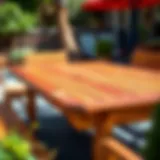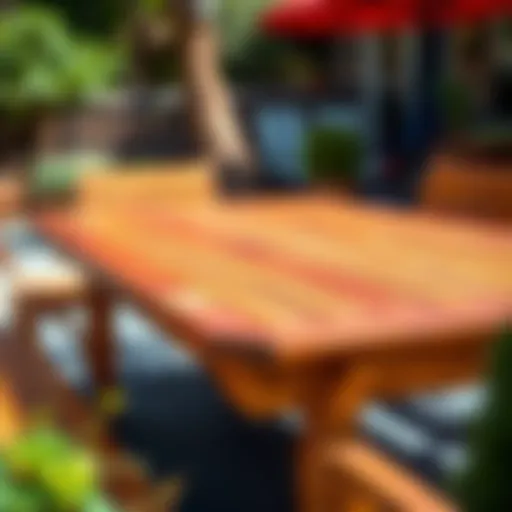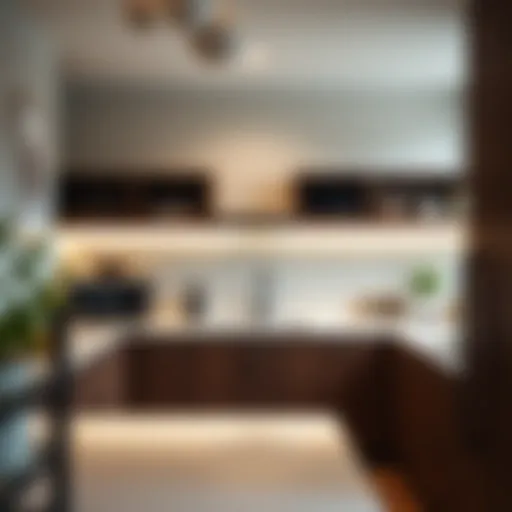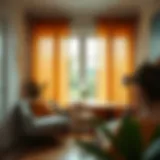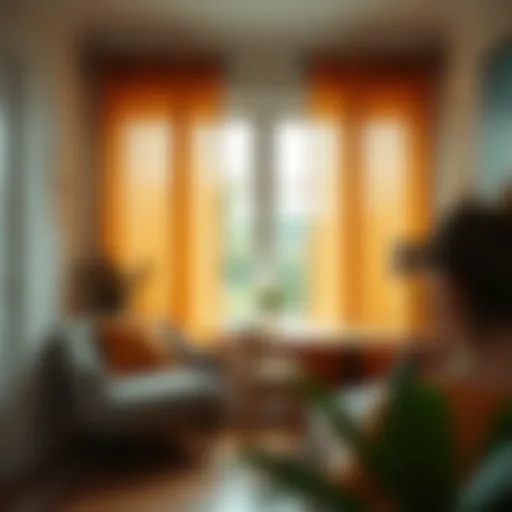Wardrobe Door Mirror Replacement: Your Complete Guide


Intro
Replacing a wardrobe door mirror can feel like a daunting task. However, it can also be an opportunity to refresh your space and keep it looking appealing. For homeowners and DIY enthusiasts alike, understanding the nuances of this project can be quite beneficial. You may want to update your mirror for aesthetics or practicality, perhaps it's broken or not suited for your current decor. Either way, this guide takes you through the process, ensuring that you have the right knowledge to tackle this task with confidence.
Not only will we walk you through the types and styles of mirrors available, but we will also delve into the tools and techniques necessary for a successful replacement. With a little preparation and initiative, you’ll be able to transform your wardrobe door and improve your room's overall vibe. Let's dive into the latest trends and styles in wardrobe mirrors that can act as a springboard for your project.
Prologue to Wardrobe Door Mirrors
Wardrobe door mirrors are more than just reflective surfaces; they serve a multitude of purposes that broaden their importance in any living space. Understanding their role is crucial for anyone considering replacement or installation. A wardrobe door mirror can transform an ordinary space into something that feels larger and more inviting. Not only do they provide a practical function for checking outfits, but they also play a key role in interior design.
Purpose and Benefits of Wardrobe Door Mirrors
The primary purpose of a wardrobe door mirror is functionality. Most people use them to get a full view of themselves while getting dressed or preparing for the day ahead. A mirror conveniently placed on a wardrobe door means you won't have to seek out another reflective surface, making your daily routine smoother.
However, the benefits of wardrobe door mirrors extend far beyond mere utility. They can also add a certain elegance to your space. When positioned correctly, mirrors can work wonders in enhancing natural light, casting brightness throughout a room. This reflection is vital in tight quarters, as it can create an illusion of expanded space, making a small room feel airy and open.
Moreover, these mirrors can also act as decorative elements. Opting for uniquely framed mirrors or even custom designs can enhance your room’s theme or style. Whether you lean towards vintage aesthetics or a sleek, modern vibe, mirrors can pull it all together.
Aesthetic Appeal and Space Perception
When it comes to aesthetic appeal, wardrobe door mirrors cannot be overstated. They can serve as a focal point or complement other design elements in the space. A well-chosen mirror can reflect artwork, light fixtures, or even the view from a window, creating layers of interest. It's like saying, "Hey, look over here!" without uttering a word.
In terms of space perception, mirrors act like little magic tricks for your home. They bounce light around, giving the illusion that rooms are larger than they might actually be. For instance, placing a full-length mirror on a narrow wardrobe door helps draw the eye along the space, breaking up visual congestion. Practically, this can be a game-changer for people with limited square footage.
In summary, understanding the importance of wardrobe door mirrors involves recognizing both their functional and aesthetic value. They can enhance your daily routines while adding character to your space, making it essential to choose the right mirror when considering a replacement.
Types of Wardrobe Door Mirrors
When considering wardrobe door mirrors, understanding the varied types available can make a significant difference in both functionality and style. The choice of mirror type can drastically influence the aesthetic of the space, as well as the mirror’s practical uses. Here we will delve into three main categories of wardrobe door mirrors: full-length, framed, and unframed mirrors. Each type has distinct advantages and particular considerations that homeowners, renters, and DIY enthusiasts should be aware of.
Full-Length Mirrors
Full-length mirrors are a popular choice, thanks in large part to their versatility. These mirrors extend from top to bottom, allowing the user to get a complete view of their outfit. Having a full-length mirror in your wardrobe can be particularly beneficial when dressing for various occasions — whether you’re choosing a professional outfit for work or a casual ensemble for a dinner outing.
In terms of practical benefits, full-length mirrors can also create the illusion of a larger space. In tighter living quarters, like small apartments, this visual expansion can make rooms feel more open and inviting. Moreover, full-length mirrors can often double as decorative elements; many come with stylish frames or designs that can enhance the overall décor of your room.
Framed Mirrors
Framed mirrors carry a certain elegance that can serve as a focal point in a room. Their framing can range from ornate gold leaf styles to sleek minimalistic designs, providing homeowners an array of choices to match their individual tastes and existing interior design.
A framed mirror not only serves the functional purpose of reflection but also incorporates an artistic element into the home. When selecting a framed mirror for a wardrobe door, it's crucial to consider the thickness and type of frame. Heavier frames might require more robust hanging solutions than slimmer designs. Furthermore, you should ensure that the frame is crafted from durable materials to resist wear and tear.
Choosing the right frame can elevate your wardrobe door mirror from merely functional to a statement piece that reflects your style.
Unframed Mirrors
On the other hand, unframed mirrors offer a sleek and modern aesthetic that appeals to many. Without a frame, these mirrors can seamlessly blend with any decor and often come in various shapes and sizes, offering a contemporary twist to the traditional mirror concept. They are also typically lighter than framed mirrors.
In addition, unframed mirrors can be quite cost-effective. Their simplicity often translates into lower price points, making them accessible for those on a budget. Installation can also be easier, as many unframed mirrors come with adhesive hangers or simple mounting options. However, even without frames, it’s essential to ensure that the edges of the glass are polished to avoid any injury.
When selecting an unframed mirror, keep in mind the location and layout of your wardrobe. A well-placed unframed mirror can enhance the natural light and reflect visual interest throughout the room.
Understanding the types of wardrobe door mirrors available is pivotal for making an informed decision. Whether opting for a full-length, framed, or unframed mirror, each type brings its unique blend of style and utility. Your choice can transform the look of your space while also enhancing the practical functions of your wardrobe.
Assessing the Need for Replacement
When it comes to wardrobe door mirrors, knowing when to replace them can save you time, effort, and possibly a few bucks. Mirrors are not just functional items; they play a pivotal role in your home's aesthetics and can even affect how you perceive space in a room. Hence, before diving into the replacement process, it’s vital to assess whether your mirror truly needs to be swapped out. Some common indicators should guide this decision-making process.
Identifying Damage
A wardrobe door mirror can suffer various forms of damage over time. Some signs are blunt, while others can be rather sneaky. Take a good look and be on the lookout for:
- Cracks and Chips: Any visible fractures are a clear indication that replacement is necessary. Even small chips can expand over time.
- Flaking Edges: If you notice any peeling or flaking around the borders of the mirror, it’s usually a sign of moisture or age, which can eventually compromise the integrity of the mirror itself.
- Distortion: If you look into the mirror and notice a wonky reflection, it may signal that the reflective layer is starting to deteriorate.
- Cloudiness or Stains: The surface should be clear and without major stains. If cleaning doesn’t improve clarity, consider replacing it.


Taking note of these signs can help you avoid dealing with a more serious issue down the track. As the old saying goes, "A stitch in time saves nine."
Evaluating the Mirror's Condition
Apart from physical damage, it's important to evaluate the overall condition of the mirror. Consider the following:
- Age of the Mirror: If it’s been hanging there for decades, it may be time to retire it. Just like any home fixture, even mirrors have a lifespan.
- Structural Integrity: Check whether the mirror is still securely mounted on the door. If it feels loose or wobbly, this can not only be annoying but dangerous as well.
- Fashion Statement: Trends change quicker than you can say "we’ve updated the living room!" If your mirror looks like it belongs in grandma’s attic, freshening it up might be in order.
If you determine that your mirror suffers from significant damage or is simply outdated, replacing it might not just be a matter of preference, but a necessity that contributes to the function and style of your living environment.
All in all, assessing the need for replacement isn't just about the object itself; it reflects your attention to detail in home maintenance and design.
Preparing for Mirror Replacement
Preparing for the replacement of a wardrobe door mirror is a crucial step in ensuring that the entire process goes off without a hitch. It's more than just grabbing a new mirror; it’s about laying the groundwork for a successful installation. Investing time in preparation can prevent mishaps and guarantee that the end result meets your aesthetic and functional expectations. When you know what to expect, the task becomes much easier and often even enjoyable.
Gathering Tools and Materials
Before launching into the mirror replacement, having the right tools and materials at hand can save you a bundle of time and potential headaches. Here’s what you’ll typically need:
- Replacement Mirror: This is the star of the show. Be it framed, unframed, or full-length, choose one that fits your wardrobe door perfectly.
- Measuring Tape: Accuracy in measurement is fundamental. A simple miscalculation can lead to a mirror that doesn’t fit properly.
- Screwdriver: Depending on how your existing mirror is attached, you’ll likely need either a Phillips or flat-head screwdriver.
- Adhesive or Mounting Tape: If your new mirror relies on glue instead of screws, gather a high-quality adhesive.
- Level: This tool ensures that your mirror hangs straight, preventing any unsightly slants that could ruin the visual appeal.
- Gloves: Not just for style; handling glass can be tricky, and gloves protect your hands.
Having these items gathered in advance means you can focus entirely on the job at hand, rather than running back and forth for tools.
Safety Precautions
When dealing with mirrors, safety should be your top priority. Mirrors involve glass, and working with glass can be dangerous if you are not careful. Here are some essential safety precautions to keep in mind:
- Wear Safety Goggles: Protect your eyes from shards of glass while removing or installing the mirror. It’s better to be safe.
- Work on a Flat Surface: Make sure the area around your wardrobe door is cleared and provides a solid area for working. A stable platform reduces the risk of accidents.
- Use Gloves: As previously mentioned, gloves guard against cuts. They also provide a better grip when handling the new mirror.
- Get Help: If your mirror is large or heavy, consider having someone lend a hand. This reduces strain and the risk of dropping the glass.
Important: Always remember to dispose of any broken glass carefully. Wrap it securely in newspaper before throwing it out, to avoid injury to yourself or others.
Taking these precautions won't turn you into a superhero, but they will certainly keep you safer as you take on this project. With the right tools and safety measures in place, you’ll be well on your way to effectively replacing that wardrobe door mirror.
The Replacement Process
Replacing a wardrobe door mirror can seem like a daunting task. However, understanding the replacement process is vital for ensuring that you not only achieve a functional solution but also enhance the aesthetics of your space. This section covers the step-by-step approach to replacing the mirror, pointing out the importance of each phase — from removing the old mirror to firmly securing the new one. Each step is interlinked, leading to a complete and polished finish. This guide aims to simplify the process for homeowners and DIY enthusiasts alike, breaking it down into manageable parts that make the job easier and more straightforward.
Removing the Old Mirror
Before you can put the new mirror in place, it’s necessary to get the old one out without a hitch. This step requires caution, as mirrors can easily break and create hazardous situations.
- Safety first: Always wear gloves and goggles to protect yourself, as shards can be sharp. You don’t want to end up in a sticky spot due to an unfortunate slip.
- Detach from the door: Depending on how the mirror was installed, you might need to unscrew it or pry it away from adhesive, if applicable.
- Take it down carefully: Tilt the mirror away gently from the door, ensuring you have a firm grip. Avoid sudden movements and keep your eyes on the path to where you’re placing it down, as you don’t want to drop it.
After the old mirror is removed, inspect the wardrobe door for any damage or residue before proceeding to the next phase.
Installing the New Mirror
Now that you’ve cleared the way, it’s time to get that shiny new mirror properly placed. This is a crucial part of the process, and each sub-step ensures that the mirror not only looks good but is also safe for everyday use.
Aligning the Mirror
Aligning the mirror isn’t just about sticking it on the door. It’s about strategic placement. Proper alignment means you’re setting the stage for a seamless look.
- Consideration: Measure the area and ensure that the mirror is centered, taking into account the door frame and other hardware. You want it visually appealing, for sure. It will give your wardrobe a polished edge.
- Key characteristic: The major benefit to aligning the mirror correctly is that it reduces the chances of future issues. A misaligned mirror might look awkward or could even result in it being unstable.
- Unique feature: Many homeowners opt for templates or positioning guides, which can make this step a breeze. Using painter's tape to mark where the edges will lie is also a tactic that adds a layer of precision to the installation.
Securing the Mirror
Once you have your mirror in line with your vision, securing it is the next crucial step. This is where the rubber meets the road, and the mirror transitions from a dream to reality.
- Technique: Whether you are using brackets or adhesive, make sure the method matches the weight and size of the mirror. Always check the manufacturer's recommendations.
- Key characteristic: A well-secured mirror minimizes the chances of accidents, which is paramount in any living space and particularly in high-traffic areas.
- Unique feature: Double-sided tape can be a simple, effective choice if you’re looking for something that doesn’t require heavy-duty tools. However, if you’re going for a more permanent solution, screws or brackets would be advantageous in ensuring strength.
Checking for Stability


After everything is set and secured, checking for stability is the final touch before you step back and admire your work. This might seem trivial, but it’s a non-negotiable step that can save you headaches down the line.
- Process: Gently press against different parts of the mirror to ensure it doesn’t wobble or shift. This is where you’d catch any sneaky errors before they become bigger problems.
- Key characteristic: A stable mirror not only guarantees functionality but also enhances your confidence in your DIY skills. You’re left with a mirror that’s ready for everyday use, standing the test of time.
- Unique feature: Investing in a spirit level can help check the positioning. If this tool is used, there is less chance of having to redo any aspect of the installation, which is always a time-saver.
The replacement process isn’t just about slapping a new mirror on a door; it’s about creating a combination of functionality and style. By taking careful steps, from removing the old mirror to ensuring that the new one is perfectly aligned and secure, you’re setting the foundation for a beautiful enhancement to your space.
Finishing Touches
Once the new mirror is installed, the last phase in the replacement process involves essential finishing touches. These details not only enhance the overall aesthetic appeal but also ensure the longevity and functionality of the new setup. Focusing on these elements can make a significant difference in how your wardrobe door mirror integrates into your living space, reflecting both style and care.
Cleaning the New Mirror
After installation, cleaning the new mirror is a straightforward, yet crucial task. It’s not just about making it shine; it's also about ensuring that all fingerprints, dust, and any potential residues from the installation process are removed. Here are some steps you can follow for optimal cleaning:
- Choose the Right Cleaner: Avoid harsh chemicals that may damage the mirror’s surface. A simple mixture of water and vinegar can work wonders. Alternatively, there are many commercial glass cleaners available that are safe for mirrors.
- Use a Soft Cloth: Microfiber cloths are ideal for this purpose since they won't scratch the surface. A clean, soft cloth will help to wipe away any streaks and leave your mirror crystal clear.
- Wipe in a Circular Motion: This technique will help to lift grime rather than pushing it around. Start from the center and work outwards to ensure an even clean without any missed spots.
- Final Check: Once done, give the mirror a final inspection for any spots you might have missed. It’s best to do this step when the mirror is dry, as wet surfaces can often hide imperfections.
Keeping your mirror clean will not only enhance its appearance but also make maintenance easier in the long run. A smudge-free surface invites a positive visual experience while executing daily routines, ensuring that your wardrobe mirror continually reflects your best self.
Adjusting Wardrobe Door Hardware
Once you have completed cleaning, the next important touch is to ensure that all hardware related to the wardrobe door is in proper working order. This step holds significant importance for a few reasons:
- Smooth Operation: Proper alignment and adjustment of the hardware ensure that the wardrobe doors open and close smoothly without any hindrance. This not only enhances functionality but also adds to the aesthetic appeal of the mirror installation.
- Preventing Future Issues: Neglecting these adjustments can result in gaps forming between the door and frame or increased wear and tear on the hinges. Addressing these now can save you trouble down the line.
Here are some key points to keep in mind when adjusting your wardrobe door hardware:
- Check Hinges: Ensure that hinges are secure and not loose. If they are, simply tighten the screws. Sometimes, a little bit of lubricating oil can help the doors swing more freely.
- Alignment Matters: Examine the door alignment. If one side sits higher than the other, you may need to adjust the hinge positioning. Loosen the screws slightly, align the door, and retighten them afterward.
- Install Bumpers: Using rubber bumpers can also prevent the doors from slamming against the frame, reducing wear on both the hardware and the door surfaces.
These finishing touches play a critical role in how the wardrobe door mirror operates within its space. Taking the time to properly clean the mirror and adjust all hardware will not only contribute to the immediate visual impact but will also extend the lifespan of your installation.
Maintenance Tips for Wardrobe Door Mirrors
Taking care of your wardrobe door mirrors is not just a matter of aesthetics; it's all about prolonging their life and serving their purpose effectively. Well-maintained mirrors add to the beauty of a room and reflect your personal style, while also providing practicality. Mirrors can easily become smudged or scratched through daily use, which is why it’s vital to establish a consistent care routine. This section details essential maintenance strategies that enhance the longevity and appearance of your wardrobe door mirrors, ensuring they remain functional and visually pleasing.
Regular Cleaning Practices
Cleaning isn’t just about wiping off the dust; it’s an art. Using the right materials can make a world of difference. For daily upkeep of your mirrors, a soft microfiber cloth is your best friend. A gentle spray of a solution made of vinegar and water can work wonders, cutting through grime without leaving streaks.
Here’s a quick rundown of effective cleaning practices:
- Microfiber Cloths: They prevent scratches and can trap dirt better than traditional fabrics.
- Vinegar and Water Solution: Mix equal parts of both, and you're good to go.
- Avoid Harsh Chemicals: These can damage the reflective coating, so stick to gentler alternatives.
"The key to a polished mirror is avoiding anything that can scratch its surface. A little care goes a long way."
Make it a habit to clean your mirrors every couple of weeks, but don’t fret if you miss a week or two. Just remember to tackle any smudges or spots as soon as you notice them. You’ll find that regular attention keeps your mirrors shining bright.
Repairing Minor Damage
Even with the most diligent maintenance, minor damages like scratches and chips can occur. Addressing these issues promptly can prevent them from spiraling into larger problems. Luckily, many small damages can be remedied at home without the need for extensive repairs.
Here are some handy tips for repairing minor scratches:
- Toothpaste Method: A dab of non-gel toothpaste on a soft cloth can help buff out small scratches. Just apply gently and wipe clean.
- Ceramic Cooktop Cleaner: For deeper scratches, a bit of ceramic cooktop cleaner can also work well. Apply with a cloth, following the manufacturer’s instructions.
- Glass Repair Kits: For those more stubborn scratches, consider investing in a glass repair kit. It's worth it if you have expensive mirrors.
Keep in mind that while these remedies can be effective, not all cracks can or should be repaired at home. Be sure to evaluate the depth and location of the damage. If your mirror is severely cracked, replacement might be the only option to ensure safety and clarity.
Regular maintenance, combined with quick damage remediation, will keep your wardrobe door mirrors in excellent shape, maximizing their use and enhancing your decor.
Considerations for DIY vs. Professional Installation
Replacing a wardrobe door mirror can be a straightforward DIY project for some, but it also requires careful consideration of various elements. Understanding whether to tackle the job yourself or enlist the help of a professional is crucial in ensuring the project is completed successfully and safely. Let’s break down some of these important factors.
Evaluating Personal Skills


Before deciding on a DIY approach, it’s essential to honestly assess your skills. Consider your familiarity with tools and techniques involved in glass installation. If you've successfully handled similar projects in the past, you might feel confident about replacing a wardrobe door mirror. However, if you often fumble during assembly of furniture from flat-pack stores, it could be a signal to rethink your DIY ambitions.
Key questions to ponder include:
- Do you know how to handle tools like a level, drill, and adhesive?
- Have you ever worked with mirrors or glass before?
- Can you follow tools’ instructions without a hitch?
It's not just about stepping up and attempting to replace the mirror; it’s about ensuring you can do so without adding more woes to your home environment. Measure and measure again, practice the installation process in your head or with a friend, and don’t forget to review safety protocols—those shards can be unforgiving.
When to Seek Professional Help
Sometimes, even the most enthusiastic DIYers have to hang up their tool belts and call in the pros. Recognizing when it’s time to seek professional help can save you a heap of trouble and potential damage.
Consider hiring a specialist if:
- The damage to your current mirror is extensive, potentially requiring custom glass work.
- You are unsure how to secure the new mirror properly, not wanting it to rattle loose or—worst case—fall down.
- You lack the necessary tools or if the thought of using them brings you cold sweat.
- Time is of the essence; professionals can often get the job done faster, allowing you to focus on other home improvement projects or simply enjoying your space.
In sum, the decision to DIY or go with a professional hinges heavily on your skills and the specific situation at hand. Ultimately, a well-executed installation, whether done yourself or through someone else, enhances the aesthetic appeal and functionality of your wardrobe door.
The peace of mind knowing when to let a pro handle complicated tasks can be priceless in home improvement ventures.
Common Issues and Solutions
Addressing common issues associated with wardrobe door mirrors is crucial, especially when managing your living space. Homeowners and DIY enthusiasts need to understand not only how to install a new mirror but also how to troubleshoot typical problems that arise after the installation process. Recognizing these potential pitfalls allows for a smoother transition and enhances the longevity and aesthetic appeal of your mirrors. This section will dive into two primary concerns: fractures and cracks, and installation gaps, providing useful tips on how to resolve them effectively.
Fractures and Cracks
Mirrors are inherently delicate, and even the slightest mishap can lead to fractures or cracks. These damages not only impact the functionality of the mirror but can also be a visual distraction and safety hazard. It's important to address these issues promptly.
Most commonly, fractures result from improper handling during installation or accidents that cause impact. For instance, if you’re not paying attention while moving furniture, you might accidentally bump into the mirror. Not only does it create a broken reflection, but it can also lead to shards that pose a risk of cuts.
Tip for Repairing: While completely replacing a fractured mirror is often the best solution, some minor cracks can be temporarily patched using specialized mirror adhesive. However, this is more of a short-term fix. If you notice a crack expanding or a more severe fracture, it’s time to replace the entire mirror.
"A broken mirror remains a broken home; it’s better to replace than to regret."
When a mirror is cracked, carefully assess whether it's something you can DIY or if you should bring in a pro. Remember, safety first! You don’t want to risk injury while attempting to fix or remove a damaged mirror.
Installation Gaps
Another common issue during the replacement process is installation gaps, which occur when the mirror does not fit snugly against the door frame. You might notice these gaps if the mirror is slightly larger or smaller than the intended space. Installation gaps can lead to an unappealing look, inviting the potential for dirt and debris to accumulate there.
Reasons for Installation Gaps:
- Incorrect Measurements: One of the key culprits is not measuring the dimensions of the mirror correctly before installation.
- Uneven Surfaces: Sometimes, the wardrobe door might not be level or flat, causing misalignment.
- Incompatible Styles: Choosing a mirror that does not harmonize with the door style can also cause gaps.
Suggested Solutions:
- Trim the Mirror: If the gap is minor, you might be able to trim the edges for a perfect fit; however, this might require specific tools and precision.
- Use a Frame: If trimming isn't an option, consider adding a decorative frame around the mirror. It can hide the gaps while enhancing the visual appeal.
- Adjust the Installation: If the gaps are a result of uneven surfaces, adjusting the way the mirror is installed might help. For instance, using shims can bring the mirror flush with the door frame.
Understanding these common issues allows you to approach your wardrobe door mirror replacement with confidence. With the right strategies and precautions, you can ensure that your mirrors are not only functional but also enhance the overall aesthetic of your living space.
Ending
In wrapping up this guide, it’s essential to understand the relevance of wardrobe door mirror replacement in enhancing both appearance and functionality of personal spaces. More than just a reflective surface, a well-chosen mirror can amplify light, create an illusion of space, and add to the overall aesthetic of the area.
Recap of the Replacement Process
Embarking on the journey of replacing a wardrobe door mirror can be simplified by adhering to a focused process. Here’s a brief recap:
- Assessment: Begin by evaluating the need for a replacement. Look for damages, such as cracks or warping.
- Preparation: Gather necessary tools such as screwdrivers, measuring tape, and adhesive, while keeping safety gear handy.
- Removal: Carefully detach the old mirror, making sure to handle it with care to avoid injury or further damage.
- Installation: Align and secure the new mirror efficiently, ensuring it is stable to prevent future complications.
- Finishing Touches: Clean the newly installed mirror and adjust hardware if needed, ensuring it complements the wardrobe perfectly.
This methodical approach not only streamlines the process, but also contributes to a safer and more visually pleasing outcome.
Final Thoughts on Wardrobe Door Mirrors
Wardrobe door mirrors are more than mere accessories; they serve practical functions while contributing significantly to your living space's aesthetic. Whether you lean towards a classic framed look or a sleek unframed design, the choice hinges largely on personal style and functional needs.
"A well-placed mirror can open up your space, reflecting not just light, but the essence of your style."
For additional resources on home improvement projects, consider checking out sites like Wikipedia or various threads on Reddit, where experienced DIYers share insights and tips.


